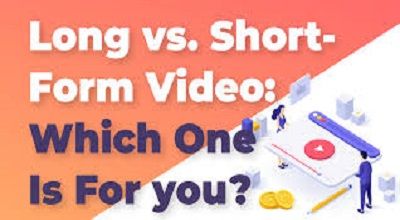Short-form vs long-form video content
The latest article is about Short-form vs long-form video content. Short-form and long-form video content cater to different audience preferences and serve distinct purposes in the digital media landscape. Here are some key differences between the two:
Short-form Video Content:
Duration:
- Typically, it ranges from a few seconds to a few minutes.
- Well-suited for quick consumption and easy sharing on social media platforms.
- Audience Engagement:
- Grabs attention quickly.
- Ideal for capturing the audience’s interest in a brief timeframe.
Platform Suitability:
- Flourishes on platforms like TikTok, Instagram Reels, Snapchat, and Twitter.
- Appeals to users with shorter attention spans or those looking for quick, entertaining content.
Content Types:
- Often focuses on entertainment, humor, or a concise message.
- Challenges, trends, and quick tutorials are popular formats.
Marketing and Branding:
- Effective for brand awareness and capturing the audience’s initial interest.
- Useful for promoting quick messages, products, or services.
Long-form Video Content:
Duration:
- Extends beyond a few minutes, ranging from 10 minutes to several hours.
- Allows for in-depth exploration of topics.
Audience Engagement:
- Requires a longer attention span.
- Appeals to audiences seeking detailed information or entertainment.
Platform Suitability:
- Platforms like YouTube, Vimeo, and OTT (Over-the-Top) services are popular for long-form content.
- Suited for storytelling, educational content, and documentaries.
Content Types:
- Enables deep dives into complex subjects.
- Suitable for tutorials, educational content, interviews, and storytelling.
Marketing and branding:
- Effective for building a brand’s authority and providing in-depth information.
- Allows for a more comprehensive presentation of products or services.
Considerations:
Audience Behavior:
- Understand the target audience’s preferences and attention spans.
- Younger audiences might prefer short-form content, while older demographics may engage more with long-form content.
Content Goals:
- Define the purpose of the content. Short-form may be better for initial engagement, while long-form is suitable for detailed information or storytelling.
Platform Strategy:
- Choose platforms that align with the content format. Short-form videos thrive on social media, while long-form content is often on dedicated platforms or websites.
Production Resources:
Consider the resources required for production. Short-form content may require creative editing and a quick production turnaround, while long-form content demands more extensive planning and execution.
Note;
In many cases, a combination of both short-form and long-form content can be part of a comprehensive content strategy, catering to a diverse audience with varying preferences and consumption habits.
